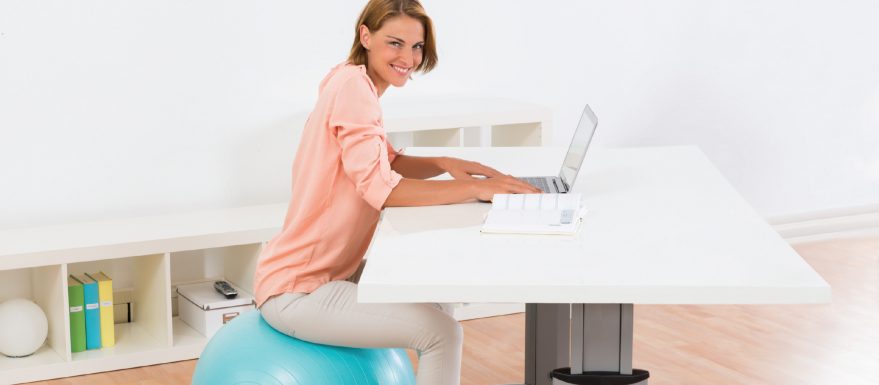Is Sitting the New Smoking?

For many of us working in offices, we spend the bulk of our waking hours sitting. Eight hours a day, five days a week, plus any couch time we clock outside of that. Unfortunately, our bodies just weren’t designed to sit for prolonged periods, and it’s doing us damage. From obesity to chronic pain, postural strain to mental health issues, diabetes to cardiovascular disease. So, what can we do about it?
“Research shows that 43.7% of Australian adults spend most of the day sitting, which is believable considering many of our work habits,” says Carly Rush of NExT Osteo & Rehab.
As an exercise physiologist, Carly works with patients to manage chronic disease. One of the common causes of many diseases is, surprisingly, sitting. Her business, co-founded with osteopath Dr Liam McCambridge, aims to help patients with pain management through to long-term lifestyle modification, with the overall goal to inspire people to better health.
“Even if you’re in a really good ergonomic set-up at your desk, with good posture, your muscles aren’t designed to hold you in that position…”
What’s the issue with sitting?
When we sit, our hip flexor and hamstring muscles tighten and joints stiffen. That affects gait and balance, making walking more difficult. If you’re someone who experiences pain, sitting can actually make that pain worse.
According to the Heart Foundation, the hazardous effects of too much sitting are strongest in those who are spend less than 30 minutes per day of moderate exercise. Those who do 60-75 minutes per day of moderate-to-vigorous exercise per day (double the recommended minimum), appear to provide themselves protection from the health implications of sitting. So, even for those who lead moderately active lives away from the office, prolonged sitting, and really any habitual inactivity, increases your risk for heart disease, as well as other issues like diabetes, obesity, osteoporosis, deep-vein thrombosis and metabolic syndrome.
Add to that, we know that inactivity has negative effect on mood, memory and productivity, all of which are important for office work.
“The most common ailments I see caused by prolonged sitting and postural strain are headaches and chronic pain, whether that’s neck or back,” says osteopath Liam. “Even if you’re in a really good ergonomic set-up at your desk, with good posture, your muscles aren’t designed to hold you in that position for an eight-hour period.”
Treatment.
“The first step is osteopathy. As an osteopath, I work with massage, stretching, joint manipulation, and resisted movements, to help reduce muscle tension and improve joint movement in that neck, shoulder and back area,” says Liam. “Then it’s over to Carly.”
“For postural issues, I focus on core strengthening and upper back strengthening to pull them back into alignment,” says Carly. “When we sit for long periods, we tend to slump over the desk, which means our chest is quite tight, our back and core are weak. I give patients exercises and tips to use at their desk to improve posture.
“Often, prescribing an hour-long exercise program to a patient with a sedentary lifestyle can be overwhelming. Initially, I like to look at building up incidental activity, so that patients clock 30 minutes of moderate activity during work hours without even needing to change into gym clothes. From that, we can help patients keep building a healthier, more active lifestyle.”
Tips to reduce postural strain.
• Structure your day in blocks. Do 45-55 minutes of work, then a few minutes of desk stretches or walking. Get up and make a tea, or refill that water glass instead of having a whole bottle at your desk. Even just a minute of two of movement can refresh your muscles.
• Move more at your desk. You don’t need a standing desk to do this. Take your phone calls standing up. Sit on an exercise ball instead of in a chair – the ball is unstable meaning you need to constantly shift weight and use muscles. Do ‘deskercises’ throughout the day. (“Deskercise is doing exercises at your desk, which can be as simple as bending your neck, tucking your chin to your chest, holding the back of your chair and twisting your body,” says Liam.)
• Incorporate incidental activity into your day. Take the stairs instead of the elevator. Walk over to your colleague instead of emailing or phoning. Park a little further away to get a few minutes of fast-paced walking each day.
• Stop eating at your desk. Moving away from your desk to eat is still movement.
• Get an ergonomic assessment of your workspace. This will look at whether your desk is at the right height, your chair suits your back, your computer screen is in the right spot, and you’re not overreaching for your mouse, phone, or other regular-use items at your desk. Your manager or HR department can arrange this.






